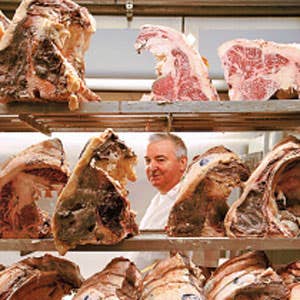
Coming of Age
Forget the "Fresher is better" rule, which applies to most meat: when it comes to beef, age is an asset. All beef—even shrink-wrapped supermarket cuts—undergoes a period of aging that tenderizes the meat, gently breaking down muscle fibers and, in some cases, ripening its flavor. Aging is especially important for steak, which is usually cooked quickly over high heat (as opposed to slower, tenderizing methods like braising).
The traditional technique, dry aging, is an art practiced by old-school butchers, meat distributors, and steak house chefs. Meat is stored in temperature- and humidity-controlled environments, gradually losing water weight and developing a rind, which is carved away. Aging time varies: some butchers believe two weeks is enough, while others age cuts for three weeks or more to concentrate flavor to a deep, nutty intensity. It's a time-consuming process, but it's essential for the best results. The difficulty of maintaining the ideal temperature and humidity—conditions crucial for preventing bacterial contamination—eliminates dry aging at home as an option for most people. Dry aging is still practiced by relatively few. In fact, 90 percent of retail-marketed beef is wet-aged.
In wet aging, cuts are vacuum-sealed in plastic after slaughter and remain there until they're butchered for sale—on average, 23 days. Some argue that, beyond tenderizing the beef, wet aging does little more than prolong shelf life and reduce cost; by contrast with dry-aged beef, wet-aged meat suffers comparably little loss in volume, but it also does not gain markedly in flavor. Others argue, however, that because wet aging allows beef to retain its moisture, it tends to produce juicier results.
Keep Reading
Continue to Next Story










